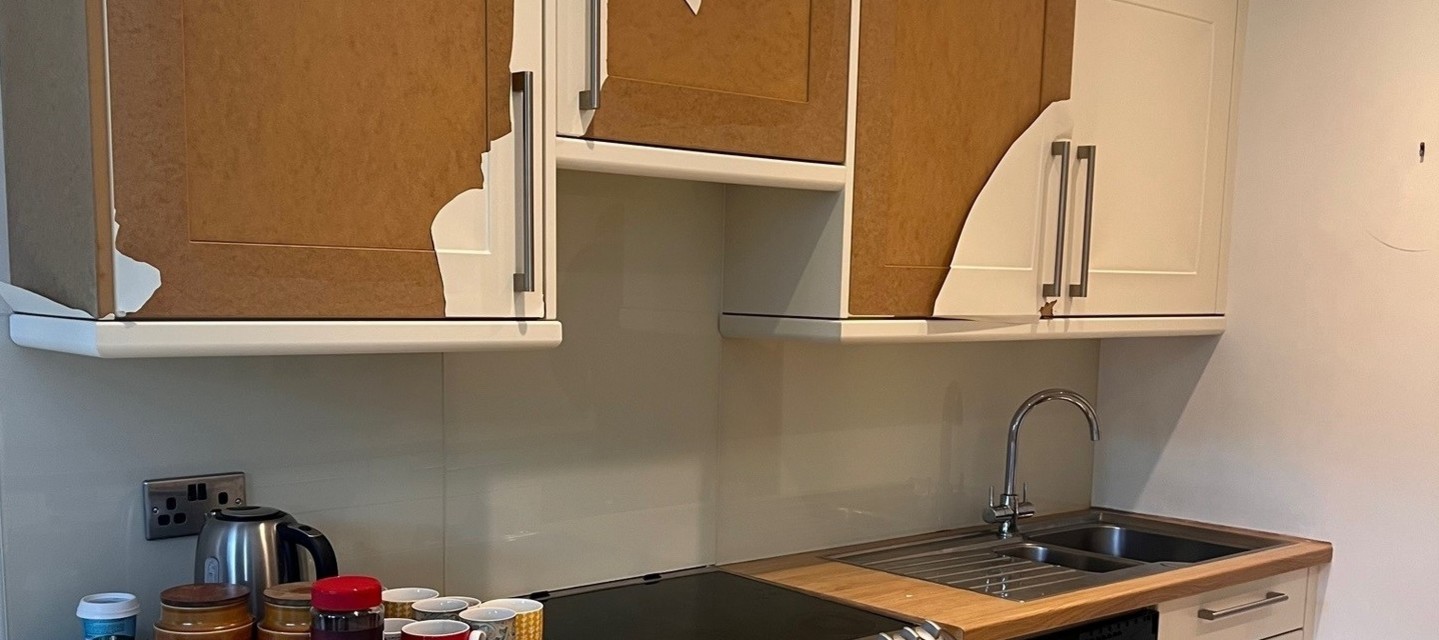How To Repair Peeling Kitchen Cupboards
Posted on 1st September 2023 at 11:32
Renovating your living space is an exciting endeavour, but sometimes, even the most carefully maintained furniture can begin to show signs of wear and tear. Cupboard doors and drawers, often covered with melamine vinyl, might begin to peel or look less than perfect over time. This is where the process of removing melamine vinyl, followed by recoating with primer and topcoat, comes into play. In this blog post, we'll guide you through the benefits of this process and explain how to fix peeling kitchen cupboard doors.


Understanding the Process
Removing melamine vinyl from cupboard doors and drawers involves a series of steps to ensure a smooth and visually appealing kitchen cupboard spraying finish. Here's a breakdown of the process:
1. Inspection: Before we begin, we will assess the condition of the melamine vinyl. If we notice peeling, bubbling, or signs of detachment, it's an indication that the vinyl has lost its adhesion and needs to be removed.
2. Preparation: We will start by clearing the area around the cupboards to create a safe and clutter-free workspace. We will then gather the necessary tools such as a heat gun, putty knife, sandpaper, and a cloth for cleaning.
3. Softening the Vinyl: We will gently use a heat gun to warm the melamine vinyl. This softens the adhesive underneath and makes it easier to peel off, keeping the heat gun moving to avoid scorching the surface.
4. Peeling Off the Vinyl: Once the vinyl is heated, we use a putty knife to carefully lift the edges of the vinyl, continuing to apply heat as needed while gently peeling off the vinyl. It is important to be patient and avoid using excessive force, to prevent damaging the underlying surface.
5. Removing Residue: After the vinyl is peeled off, there may adhesive residue left on the surface. We use a mild adhesive remover and a cloth to clean off the residue, being cautious not to damage the cupboard door or drawer.
6. Sanding: We then lightly sand the surface to create a smooth texture for the new primer and top coat to adhere to, wiping down all surfaces with a tack rack to remove contaminants and dust.
7. Priming and Top Coating: We will then begin application of a high-quality primer designed for the material of your cupboard doors. This provides a solid base for the top coat and ensures proper adhesion. Once the primer is dry, it will be sanded again using a less abrasive sanding disk to remove any raised fibres in the mdf. Another coat of primer is then applied, before being de-nibbed and sent for application of top coat.
Once we are satisfied with the primed MDF, the doors will be given 2 coats of paint in your chosen colour to finish.


Benefits of the Process
Enhanced Aesthetics: Removing peeling or damaged melamine vinyl and applying fresh primer and top coat can give your cupboard doors and drawers a new lease on life. The smooth, even finish will enhance the overall aesthetics of your space.
Increased Durability: The process of removing old vinyl and recoating with primer and top coat adds a layer of protection to your cupboards. This makes them more resistant to scratches, moisture, and daily wear and tear.
Cost-Effective Solution: Instead of completely replacing your cupboards, this process offers a cost-effective way to revitalize your furniture. It saves you money while still achieving a desirable outcome.
When and Why to Perform the Process
The process of removing melamine vinyl and recoating becomes necessary when you notice signs of deterioration, such as peeling, bubbling, or blowing off the door face. Melamine vinyl, when not adhering properly, can compromise the visual appeal of your cupboards and expose the underlying material to potential damage. By addressing these issues promptly, you not only maintain the aesthetics of your living space but also protect your investment in furniture. Regular maintenance and timely repairs can significantly extend the lifespan of your cupboards, ensuring that they remain an attractive and functional part of your home for years to come.
In conclusion, the process of removing melamine vinyl from cupboard doors and drawers and recoating them with primer and top coat offers a range of benefits, from improved aesthetics to increased durability. Performing this process when the vinyl is peeling or has blown off the door face allows you to address the issue and give your cupboards a fresh and appealing look. So, roll up your sleeves and embark on this DIY project to transform your living space effortlessly.
FAQ’s
Q1: Why is the melamine vinyl on my cupboard doors peeling off?
A1: Melamine vinyl can peel off due to factors like poor adhesive quality, exposure to moisture, heat, or age. When the adhesive weakens or loses its bond, the vinyl begins to peel or bubble.
Q2: Can I simply paint over the peeling melamine vinyl?
A2: It's not recommended to paint over peeling melamine vinyl directly. The peeling vinyl can affect the adhesion and appearance of the new paint. It's best to remove the peeling vinyl and properly prepare the surface before applying primer and top coat.
Q3: Is this process suitable for all types of cupboard doors and drawers?
A3: The process is generally suitable for most melamine-covered surfaces. However, it's essential to assess the material and condition of your cupboards before proceeding. Seek professional advice if you're unsure.


Share this post:



